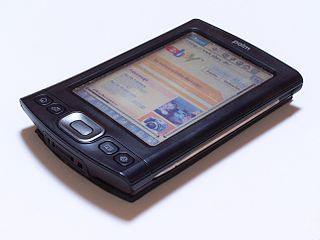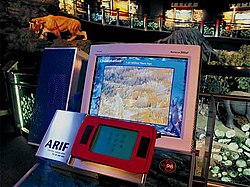
A personal digital assistant (PDA), also known as a handheld PC, is a multi-purpose mobile device which functions as a personal information manager. PDAs have been mostly displaced by the widespread adoption of highly capable smartphones, in particular those based on iOS and Android, and thus saw a rapid decline in use after 2007.

Handwriting recognition (HWR), also known as handwritten text recognition (HTR), is the ability of a computer to receive and interpret intelligible handwritten input from sources such as paper documents, photographs, touch-screens and other devices. The image of the written text may be sensed "off line" from a piece of paper by optical scanning or intelligent word recognition. Alternatively, the movements of the pen tip may be sensed "on line", for example by a pen-based computer screen surface, a generally easier task as there are more clues available. A handwriting recognition system handles formatting, performs correct segmentation into characters, and finds the most possible words.

Graffiti is an essentially single-stroke shorthand handwriting recognition system used in PDAs based on the Palm OS. Graffiti was originally written by Palm, Inc. as the recognition system for GEOS-based devices such as HP's OmniGo 100 and 120 or the Magic Cap-line and was available as an alternate recognition system for the Apple Newton MessagePad, when NewtonOS 1.0 could not recognize handwriting very well. Graffiti also runs on the Windows Mobile platform, where it is called "Block Recognizer", and on the Symbian UIQ platform as the default recognizer and was available for Casio's Zoomer PDA.

GO Corporation was founded in 1987 to create portable computers, an operating system, and software with a pen-based user interface. It was famous not only for its pioneering work in Pen-based computing but as well as being one of the most well-funded start-up companies of its time.

Apple Inc. uses a large variety of typefaces in its marketing, operating systems, and industrial design with each product cycle. These change throughout the years with Apple's change of style in their products. This is evident in the design and marketing of the company. The current logo is a white apple with a bite out of it, which was first utilized in 2013.

Newton OS is a discontinued operating system for the Apple Newton PDAs produced by Apple Computer, Inc. between 1993 and 1997. It was written entirely in C++ and trimmed to be low power consuming and use the available memory efficiently. Many applications were pre-installed in the ROM of the Newton to save on RAM and flash memory storage for user applications.
General Magic was an American software and electronics company co-founded by Bill Atkinson, Andy Hertzfeld, and Marc Porat. Based in Mountain View, California, the company developed precursors to "USB, software modems, small touchscreens, touchscreen controller ICs, ASICs, multimedia email, networked games, streaming TV, and early e-commerce notions." General Magic's main product was Magic Cap, the operating system used in 1994 by the Motorola Envoy and Sony's Magic Link PDA. It also introduced the programming language Telescript. After announcing it would cease operations in 2002, it was liquidated in 2004 with Paul Allen purchasing most of its patents.
Inkwell, or simply Ink, is the name of the handwriting recognition technology developed by Apple Inc. and built into the Mac OS X operating system. Introduced in an update to Mac OS X v10.2 "Jaguar", Inkwell can translate English, French, and German writing. The technology made its debut as "Rosetta", an integral feature of Apple Newton OS, the operating system of the short-lived Apple Newton personal digital assistant. Inkwell's inclusion in Mac OS X led many to believe Apple would be using this technology in a new PDA or other portable tablet computer. None of the touchscreen iOS devices – iPhone/iPod/iPad – has offered Inkwell handwriting recognition. However in iPadOS 14 handwriting recognition has been introduced, as a feature called Scribble.
A voice-user interface (VUI) enables spoken human interaction with computers, using speech recognition to understand spoken commands and answer questions, and typically text to speech to play a reply. A voice command device is a device controlled with a voice user interface.
ShapeWriter was a keyboard text input method for tablet, handheld PCs, and mobile phones invented by Shumin Zhai and Per Ola Kristensson at IBM Almaden Research Center and the Department of Computer and Information Science at Linköping University.

The eMate 300 is a personal digital assistant designed, manufactured and sold by Apple Computer to the education market as a low-cost laptop running the Newton operating system. It was the only Apple Newton Device with a built-in keyboard. The eMate was introduced on March 7, 1997 for US$799 and was discontinued along with the Apple Newton product line and its operating system on February 27, 1998.

A tablet computer, commonly shortened to tablet, is a mobile device, typically with a mobile operating system and touchscreen display processing circuitry, and a rechargeable battery in a single, thin and flat package. Tablets, being computers, have similar capabilities, but lack some input/output (I/O) abilities that others have. Modern tablets largely resemble modern smartphones, the only differences being that tablets are relatively larger than smartphones, with screens 7 inches (18 cm) or larger, measured diagonally, and may not support access to a cellular network. Unlike laptops, tablets usually run mobile operating systems, alongside smartphones.
The term PenPad was used as a product name for a number of Pen computing products by different companies in the 1980s and 1990s. The earliest was the Penpad series of products by Pencept, such as the PenPad M200 handwriting terminal, and the PenPad M320 handwriting/gesture recognition tablet for MS-DOS and other personal computers.

The Advanced Technology Group (ATG) was a corporate research laboratory at Apple Computer from 1986 to 1997. ATG was an evolution of Apple's Education Research Group (ERG) and was started by Larry Tesler in October 1986 to study long-term research into future technologies that were beyond the time frame or organizational scope of any individual product group. Over the next decade, it was led by David Nagel, Richard LeFaivre, and Donald Norman. It was known as Apple Research Labs during Norman's tenure as VP of the organization. Steve Jobs closed the group when he returned to Apple in 1997.

Pen computing refers to any computer user-interface using a pen or stylus and tablet, over input devices such as a keyboard or a mouse.
A text entry interface or text entry device is an interface that is used to enter text information in an electronic device. A commonly used device is a mechanical computer keyboard. Most laptop computers have an integrated mechanical keyboard, and desktop computers are usually operated primarily using a keyboard and mouse. Devices such as smartphones and tablets mean that interfaces such as virtual keyboards and voice recognition are becoming more popular as text entry systems.

The Newton is a series of personal digital assistants (PDAs) developed and marketed by Apple Computer, Inc. An early device in the PDA category, it was the first to feature handwriting recognition. Apple started developing the platform in 1987 and shipped the first devices in August 1993. Production officially ended on February 27, 1998. Newton devices ran on a proprietary operating system, Newton OS; examples include Apple's MessagePad series and the eMate 300, and other companies also released devices running on Newton OS. Most Newton devices were based on the ARM 610 RISC processor and all featured handwriting-based input.
The history of tablet computers and the associated special operating software is an example of pen computing technology, and thus the development of tablets has deep historical roots. The first patent for a system that recognized handwritten characters by analyzing the handwriting motion was granted in 1914. The first publicly demonstrated system using a tablet and handwriting recognition instead of a keyboard for working with a modern digital computer dates to 1956.

Microsoft Tablet PC is a term coined by Microsoft for tablet computers conforming to a set of specifications announced in 2001 by Microsoft, for a pen-enabled personal computer, conforming to hardware specifications devised by Microsoft and running a licensed copy of Windows XP Tablet PC Edition operating system or a derivative thereof.

The first-generation iPad is a tablet computer designed and marketed by Apple Inc. as the first device in the iPad lineup of tablet computers. The device features an Apple A4 SoC, a 9.7 in (250 mm) touchscreen display, and, on certain variants, the capability of accessing cellular networks. Using the iOS operating system, the iPad can play music, send and receive email and browse the web. Other functions, which include the ability to play games and access references, GPS navigation software and social network services can be enabled by downloading apps.




















